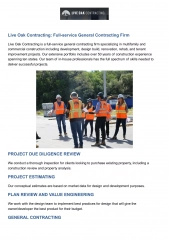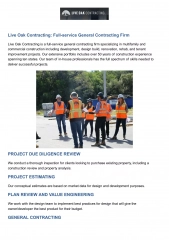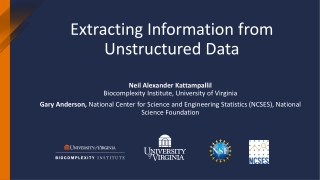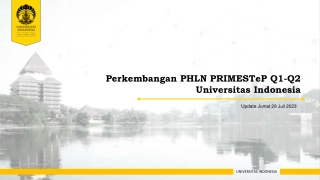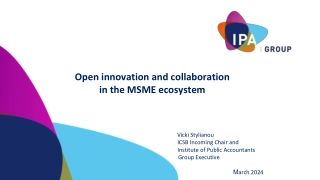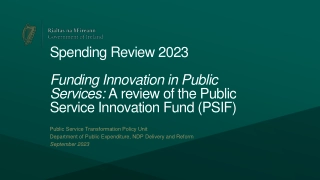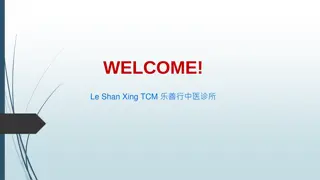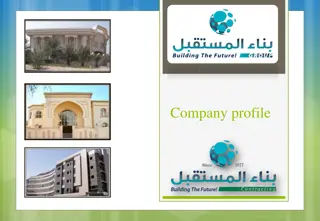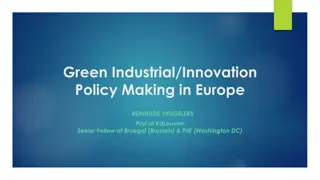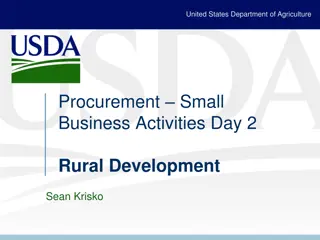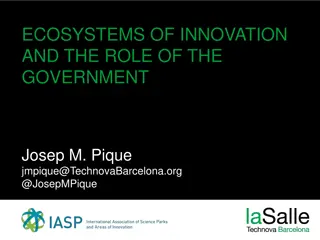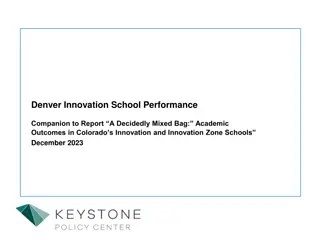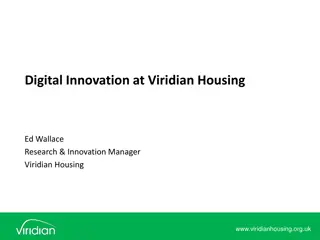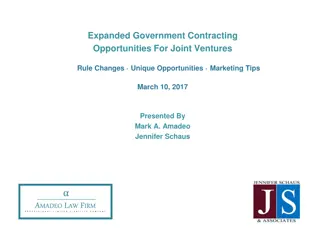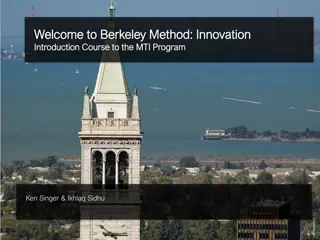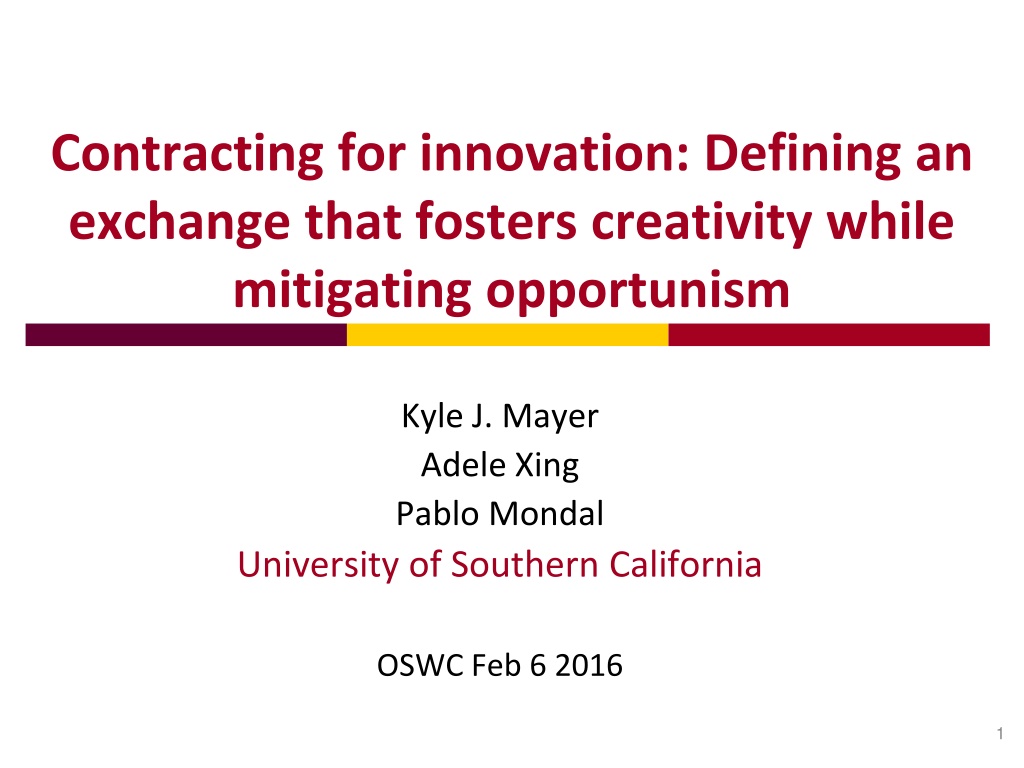
Fostering Innovation in Inter-Firm Transactions
Exploring the dynamics of innovation within inter-firm transactions, this research delves into how alliances and networks impact innovation output. It discusses the governance structures needed to balance risk avoidance with creativity fostering in these transactions, emphasizing on contract design, governance tensions, and exchange hazards that can hinder innovation. The study highlights the importance of designing effective inter-firm relationships to drive innovation within collaborative environments.
Download Presentation

Please find below an Image/Link to download the presentation.
The content on the website is provided AS IS for your information and personal use only. It may not be sold, licensed, or shared on other websites without obtaining consent from the author. If you encounter any issues during the download, it is possible that the publisher has removed the file from their server.
You are allowed to download the files provided on this website for personal or commercial use, subject to the condition that they are used lawfully. All files are the property of their respective owners.
The content on the website is provided AS IS for your information and personal use only. It may not be sold, licensed, or shared on other websites without obtaining consent from the author.
E N D
Presentation Transcript
Contracting for innovation: Defining an exchange that fosters creativity while mitigating opportunism Kyle J. Mayer Adele Xing Pablo Mondal University of Southern California OSWC Feb 6 2016 1
Inter-firm Influences on Innovation Extant research has examined the roles of alliances and networks on innovation Ties with other firms can enhance the innovation output of the focal firm Effect of learning in alliances on firm-level innovation Current gap: Innovation that occurs in the context of multiple firms working together i.e., when the need to innovate arises from within the inter-firm transaction the firms are working on 2
Research Question How can firms design and govern inter-firm transactions that require innovation to complete?
Governance and Framing Tension: TCE Governance Innovation TCE: Limit downside risk (i.e., avoiding a negative outcome) Innovation: Create a positive environment that fosters creativity (i.e., creating a positive outcome) (Could also view this as a tension between value creation innovation and value capture TCE) Governance needs to provide safeguards to mitigate downside risk may be suboptimal for promoting more innovative solutions 4
Contracts and Governance Task Description Specification of what must be done; includes: How processes, specific tasks, etc. What outcome standards and/or specifications Contingency Planning How to deal with situations that might arise during execution of the exchange Payment Mechanism (Contract Type) Fixed Fee: Needs to be concrete Time & Materials: Can be more open ended Hybrid T&M with a cap: A combination of FF and T&M
Innovation and Exchange Hazards What types of exchange hazards may be most disruptive to creating an environment to encourage innovation? Measurement cost likely the biggest issue as it can cloud the true performance metrics of the exchange outcome Need for innovation + Measurement cost ?
Innovation and Task Description Innovation may lead to more contractual attention to specifying what exactly is required to complete the task Not telling the supplier how to do the task (i.e. focus on the outcome) Outcome based contract is problematic when output of the task is difficult to measure Buyers will focus on controlling or monitoring the input process rather than the output H1: Need for innovation more task description H2: Negatively moderated by measurement cost 7
Innovation and Contingency Planning CP addresses how you deal with issues that may arise Can be open-ended and provide flexibility Can specify how to deal with challenges that may occur during the innovation effort CP may be more valuable when measurement cost is high with need for innovation Can address contingencies related to challenges in the innovation effort while also addressing hazards H3: Need for innovation more contingency planning H4: Positively moderated by measurement cost 8
Contract Type/Payment Mechanism Hybrid contract (i.e., T&M with cap) may be better for innovation Problems with Fixed Fee and T&M Caps costs addresses incentive to pad costs If below cap, controls temptation to shirk on quality Key: Allows flexibility to deal with uncertainty of need for innovation, within boundaries Avoids need to exercise too much control Hybrid payment may be less effective when measurement cost is high Uncertainty increases significantly from hazards + need for innovation Harder to agree on cap H5: Need for innovation Hybrid contracts H6: Negatively moderated by measurement cost 9
Overall Framework Contract Design Task Description H1 (+) Contingency Planning H3 (+) Need for Innovation H5 (+) H2 (-) Hybrid Payment H4 (+) H6 (-) Measurement Cost 10
Data Sample 405 contracts from a single IT supplier (Compustar) with 141 buyer firms buyers are mainly large firms or government entities Compustar was traditionally a hardware firm (primarily mainframes) and entered the IT services industry in 1986 Each contract governs a separate project They range in size from a few days (and about $1,000) to over a year (and over $1M) These contracts are not outsourcing of the entire IT function, but instead involve Compustar performing some type of IT service for the buyer Coding Two experienced Compustar engineers familiar with the contracts library coded several sample variables
Measurement Dependent Variables TASK DESCRIPTION: coded by our engineers on a 1-7 Likert- type scale; 1: very generic--minimal what and no how specified 7: detailed specs for what to do and how it will be done CONTINGENCY PLANNING: 0 = None 1 = Some contingency planning was included in the contract PAYMENT: 1 = Hybrid: Time and materials contract with a cap 0 = other payment mechanism (fixed fee or pure time & materials contract)
Measurement Key Independent Variables INNOVATION: an ordinal variable that ranges from 1 for projects that require no innovation to complete to 7 for projects that cannot be completed without a technological breakthrough Nothing was coded as 7, so effective range is 1 to 6 MEASUREMENT COST: a dummy variable that is coded as 1 if the quality of the final product is difficult to ascertain immediately upon completion of the project
Measurement Control Variables Exchange Hazards Appropriability Interdependence Ability to Disrupt Firm-level capabilities Programming (0/1) Other Firm s Hardware (0/1) Own Hardware (0/1) Mainframe (0/1) Criticality of the project to the customer (i.e., the cost of a mistake on a project): Dummy variable Relationship between Compustar and the customer Prior IT projects Compustar has completed for the customer Other Compustar products purchased by the customer Dollar Value of the Project Year Fixed-Effects
Preliminary Analysis Hypotheses testing using raw data
Results (H1, H2) VARIABLES Innovation Measurement Cost Measurement Cost Innovation Control variables Observations R-squared F-Value Model (1) Model (2) 0.320*** (0.080) Model (3) -0.357* (0.199) Model (4) 0.395*** (0.084) -0.633*** (0.207) Model (5) 0.585*** (0.124) 0.256 (0.484) -0.340** 396 0.228 7.139*** 396 0.260 7.807*** 396 0.235 7.132*** 396 0.280 8.437*** (0.168) 396 0.290 8.356*** ? 1) Robust standard errors in parentheses; 2) Year Fixed-Effects included; 3)*** p<0.01, ** p<0.05, * p<0.1 for two-tailed tests 16
Results (H3, H4) VARIABLES Innovation Measurement Cost Measurement Cost Innovation Control Variables Observations Chi-Squared Pseudo R-Squared ? 1) Robust standard errors in parentheses; 2) Year Fixed-Effects included; 3)*** p<0.01, ** p<0.05, * p<0.1 for two-tailed tests Model (1) Model (2) Model (3) Model (4) Model (5) 0.053 (0.068) -0.208 (0.163) 397 397 397 92.04*** 91.35*** 93.92*** 93.08*** 97.21*** 0.232 0.233 0.235 0.087 (0.069) -0.270 (0.166) 397 0.035 (0.104) -0.536 (0.390) 0.100 (0.133) 397 0.237 0.239 17
Results (H5, H6) VARIABLES Innovation Measurement Cost Measurement Cost Innovation Control Variables Observations Chi-Squared Pseudo R-Squared Model (1) Model (2) Model (3) Model (4) Model (5) 0.275*** (0.094) -0.045 (0.203) 0.300*** (0.105) -0.237 (0.229) 0.541*** (0.150) 0.769 (0.555) -0.367* 367 38.58*** 0.148 367 41.65*** 0.183 367 39.47*** 0.148 367 43.34*** 0.188 (0.193) 367 49.75*** 0.202 ? 1) Robust standard errors in parentheses; 2) Year Fixed-Effects included; 3)*** p<0.01, ** p<0.05, * p<0.1 for two-tailed tests 18
Overall Results Contract Design Task Description H1 (+) Contingency Planning H3 (+) Need for Innovation H5 (+) H2 (-) Hybrid Payment H4 (+) H6 (-) Measurement Cost 19
Additional Tests Simulation-based approach to test the interaction effect (Zelner, 2009) Aggregate all types of hazards Results still hold Measurement cost drives the findings Where to go if not Hybrid? FF or T&M? Split Sample into Hybrid vs. FF and Hybrid vs. T&M T&M! firms use T&M contracts to avoid the difficulty of identifying the cap in a hybrid payment mechanism when the exchange hazard is high and innovation is required
Implications Contract design is influenced by considerations of safeguards and innovation Task description gives way to contingency planning when hazards and innovation are both required Hybrid contracts can t accommodate both innovation and significant exchange hazards shift to T&M More outsourcing of innovative activities may lead firms to modify how they write their contracts Failure to adapt the contract may lead to suboptimal outcome Need more research in this area
Simulation based approach/Graphic Interpretation Why because the coefficient of interaction term in nonlinear models (e.g., probit model) may not represent the true interaction effect as we see in linear models (Norton et al., 2004). How (Zelner, 2009) 1) We simulated the distribution of the estimated coefficients directly by repeatedly drawing new values of them from the normal distribution (instead of constructing confidence intervals based on standard errors) 2) Then we calculated the predicted probabilities (and the differences of predicted probabilities) based on the simulated distribution of coefficients 3) We plotted the mean of predicted probabilities and calculate the significance interval.


